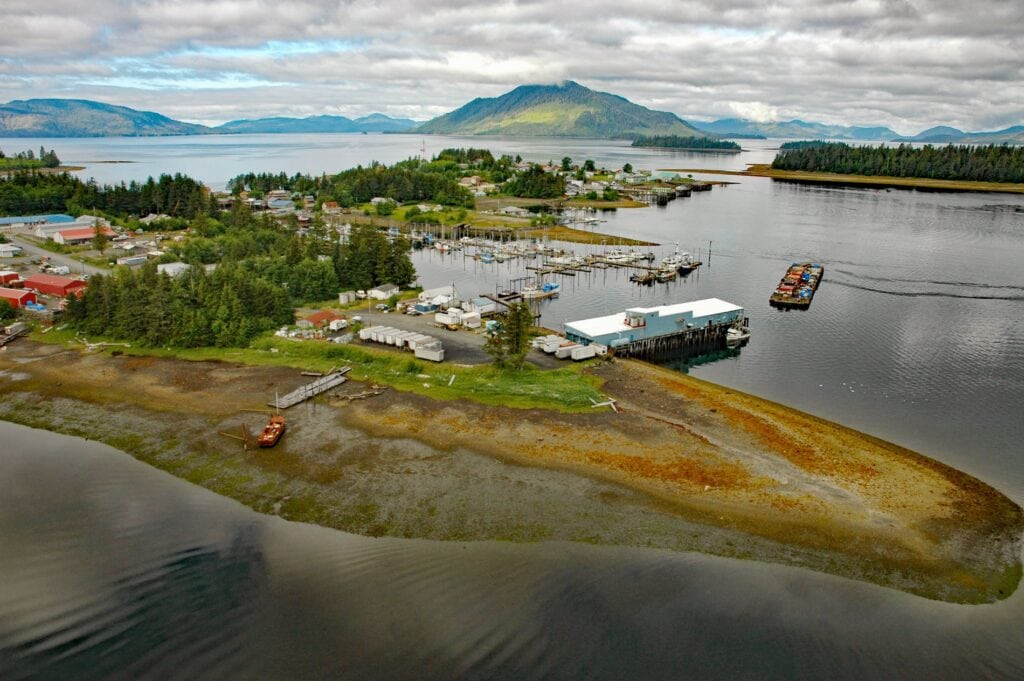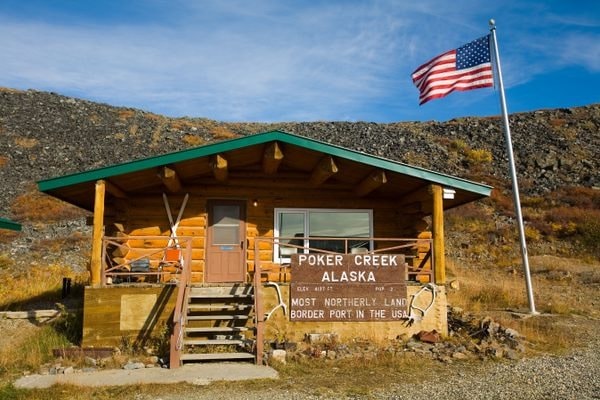Alaska is a vast and beautiful state with a rich history spanning thousands of years. From the indigenous peoples who have called this land home for centuries to the settlers and gold rush prospectors who arrived in the 19th and 20th centuries, Alaska’s history is as diverse as its landscapes.
In this article, we will explore the 10 oldest cities in Alaska and delve into their unique stories. Each of these cities has a rich history and a distinctive culture shaped by the people who have called them home over the years.
From the first Russian settlements to the bustling boom towns of the gold rush era, these cities offer a fascinating glimpse into Alaska’s past and present. Join us on a journey through time as we discover the fascinating stories behind these historic Alaskan cities, and learn more about the diverse cultures and people that have shaped this unique state.
10. Hydaburg
Year Incorporated: 1927
Class: First Class
Land Area: 1.5 sq. km.
Population (2020): 380

Hydaburg is a small city on the Prince of Wales Island in Southeast Alaska. It is home to the Haida people, who have lived in the region for thousands of years and have a rich culture and history.
The city is named after the Hydaburg Totem Pole, which was carved by a local Haida artist and is one of the tallest totem poles in the world, standing 42 feet tall. The Haida people have a strong connection to the sea and traditionally rely on fishing, hunting, and gathering for their subsistence.
In addition to its rich cultural heritage, Hydaburg is also known for its beautiful scenery and wildlife, with opportunities for outdoor recreation such as hiking, kayaking, and whale watching. Visitors can also explore the city’s museums and cultural centers to learn more about the Haida people and their traditions.
Did You Know?
Today, the city is still primarily a fishing community and is home to a commercial fishing fleet that brings in salmon, halibut, and crab.
9. Craig
Year Incorporated: 1922
Class: First Class
Land Area: 18.6 sq. km.
Population (2020): 1,036

Craig is a picturesque city on the western coast of Prince of Wales Island in Alaska. Rugged terrain, dense forests, and the Pacific Ocean surround it. The city is known for its natural beauty, abundant wildlife, and thriving fishing industry.
Despite its remote location, Craig is a vibrant community with various amenities and services. The city has a modern harbor and marina, home to a fleet of fishing vessels that supply seafood to markets worldwide.
There are also several seafood processing plants and canneries located in the city. The downtown area of Craig is small but charming, with a range of shops, restaurants, and businesses. The city also has a community center, library, and other public facilities. The residents of Craig are friendly and welcoming, and the city has a strong sense of community spirit.
Did You Know?
The city is also a popular destination for wildlife enthusiasts, with opportunities to see bald eagles, bears, whales, and other animals in their natural habitat.
8. Nenana
Year Incorporated: 1921
Class: Home Rule
Land Area: 15.3 sq. km.
Population (2020): 358

Nenana is a small city located in the central interior region of Alaska. It is situated on the banks of the Tanana River, approximately 55 miles southwest of Fairbanks. Nenana’s rich history dates back to the late 19th century, when it served as a trading post for the region’s Tanana Athabaskans and other indigenous peoples.
The city was later established as a transportation hub during the early 1900s when it became a major stop along the Alaska Railroad. One of the most popular attractions in Nenana is the Nenana Ice Classic. This annual event involves placing a tripod on the frozen Tanana River and allowing the ice to melt until the tripod tips over. The event has been held annually since 1917 and attracts visitors from all over the state.
Today, Nenana is a quiet and peaceful community known for its scenic beauty and outdoor recreation opportunities. Pristine wilderness areas surround the city and are home to a diverse array of wildlife, including moose, bears, and wolves.
Did You Know?
The city is also home to several parks and playgrounds and a community center that hosts events and activities throughout the year.
7. Seward
Year Incorporated: 1912
Class: Home Rule
Land Area: 36.5 sq. km.
Population (2020): 2,717

Seward is a small coastal city located on the eastern shore of the Kenai Peninsula in Alaska. It is situated at the head of Resurrection Bay, approximately 125 miles south of Anchorage.
Seward is a popular destination for visitors to Alaska, thanks in part to its stunning natural beauty and a wide variety of recreational opportunities. The city is surrounded by snow-capped mountains, glaciers, and pristine wilderness areas, making it an ideal location for hiking, fishing, kayaking, and other outdoor activities.
One of the most popular attractions in Seward is the Kenai Fjords National Park, located just outside the city. The park is home to various wildlife, including sea lions, seals, whales, and seabirds, as well as several glaciers easily accessible by boat.
Did You Know?
Seward is also home to various festivals and events throughout the year, including the Seward Silver Salmon Derby, the Mount Marathon Race, and the Polar Bear Jump-Off.
6. Cordova
Year Incorporated: 1909
Class: Home Rule
Land Area: 155.3 sq. km.
Population (2020): 2,609

Cordova is a small city on the coast of Alaska that sits at the foot of the Chugach Mountains. It’s famous for its beautiful scenery, abundant wildlife, and active fishing industry. The city is home to a large fleet of commercial fishing boats that provide seafood to markets worldwide.
Visitors to Cordova can explore the Copper River Delta, a vast wetland area popular for wildlife enthusiasts.
Several museums and historic sites also showcase the city’s cultural heritage, including the Cordova Historical Museum and the Cordova Center. Whether you’re a resident or a visitor, Cordova’s natural beauty and small-town charm make it a great place.
Did You Know?
In addition to these attractions, Cordova offers plenty of opportunities for outdoor recreation, such as hiking, fishing, and kayaking.
5. Fairbanks
Year Incorporated: 1903
Class: Home Rule
Land Area: 82.1 sq. km.
Population (2020): 32,515

Fairbanks is the second-largest city in Alaska and is located in the heart of the state, about 120 miles south of the Arctic Circle. It is known for its extremely cold winter temperatures but for its beautiful natural scenery and unique cultural attractions.
One of the most popular attractions in Fairbanks is the Northern Lights, also known as the Aurora Borealis, which can be seen in the city during winter.
Visitors can also tour the Aurora Ice Museum, which features ice sculptures and an ice bar, or visit the University of Alaska Fairbanks to learn about the science behind the Northern Lights. In addition to the Northern Lights, Fairbanks is also known for its hot springs, which are located just outside the city.
The Chena Hot Springs Resort offers visitors a chance to soak in natural hot springs, take a dog sled ride, or go snowmobiling in the winter.
Did You Know?
The city is home to several parks, including the Creamer’s Field Migratory Waterfowl Refuge, a popular spot for birdwatching and wildlife viewing.
4. Eagle
Year Incorporated: 1901
Class: Second Class
Land Area: 2.6 sq. km.
Population (2020): 83

Eagle is a small town located in the Interior region of Alaska, near the Canadian border. It is situated on the banks of the Yukon River and is known for its rich history and natural beauty. Eagle is a popular destination for outdoor enthusiasts, with hunting, fishing, and hiking opportunities in the surrounding wilderness areas.
The town is also a gateway to the Yukon-Charley Rivers National Preserve, home to diverse wildlife. It offers visitors a chance to explore the wild and scenic beauty of the region. In addition to its natural attractions, Eagle is also known for its historical sites and cultural heritage.
The town was a key trading post during the Klondike Gold Rush, and many of its original buildings and structures have been preserved as part of the Eagle Historic District.
Did You Know?
Visitors can explore the district’s museums and art galleries or tour the town’s historic buildings and landmarks.
3. Nome
Year Incorporated: 1901
Class: First Class
Land Area: 32.7 sq. km.
Population (2020): 3,699

Nome is a coastal city in western Alaska near the Bering Strait. Its highlights are its history, culture, and natural beauty. It originated as a gold-mining town in the late 1800s and still features the remnants of its mining past. Nome’s Iditarod Trail Sled Dog Race is a world-famous event.
One of Nome’s major attractions is its stunning beaches, renowned for their gold and agate deposits. Nome has several museums and cultural centers, including the Carrie M. McLain Memorial Museum and the Nome Gold Rush Cemetery. Outdoor enthusiasts will appreciate Nome’s location on the Seward Peninsula’s edge, which provides hiking, camping, and wildlife observation opportunities.
Nome is a unique and captivating city that allows visitors to experience the beautiful nature and cultural heritage of Alaska’s western region, making it a must-see destination for anyone interested in exploring this unique part of the world.
Did You Know?
Visitors can also enjoy boat tours of the Bering Sea, seeing marine creatures such as whales and seals.
2. Valdez
Year Incorporated: 1901
Class: Home Rule
Land Area: 560.1 sq. km.
Population (2020): 3,985

Valdez is a coastal city in southern Alaska, surrounded by stunning natural beauty. It is known for its rich history, cultural attractions, and outdoor activities. Valdez was incorporated in, but today it is more famous for its deep-water port, which serves as a hub for shipping and transportation in the region.
Visitors can learn more about the city’s history by visiting the Valdez Museum and Historical Archive, which features exhibits on the city’s past and its natural and cultural heritage. One of the biggest attractions in Valdez is its stunning natural scenery. The city is located at the foot of the Chugach Mountains, which offer opportunities for hiking, skiing, and other outdoor activities.
Did You Know?
Visitors can also explore the nearby Prince William Sound, home to various marine life, including sea otters, seals, and whales.
1. Ketchikan
Year Incorporated: 1900
Class: Home Rule
Land Area: 11.3 sq. km.
Population (2020): 8,192

Ketchikan is the oldest incorporated city in Alaska and is located in the southeastern part of the state. The city was founded as a fishing camp in the late 1800s and was officially incorporated in 1900. Today, Ketchikan is a bustling community with around 8,000 residents.
One of the most interesting aspects of Ketchikan’s history is its strong ties to the fishing industry. In the early days, the city was a hub for the commercial fishing industry, and many of the town’s residents made their living as fishermen. Today, Ketchikan remains an important center for the seafood industry and is known for its salmon and halibut fisheries.
Another notable feature of Ketchikan is its unique architecture. The city is built on steep hillsides, and many buildings are constructed on stilts or pilings extending out over the water. This construction style is known as “boardwalk architecture” and is a nod to the city’s early days as a fishing camp.
Did You Know?
Ketchikan is also home to a thriving arts community. The city is known for its totem poles, which local Native American artists carve, and there are several galleries and studios where visitors can view and purchase works of art.











